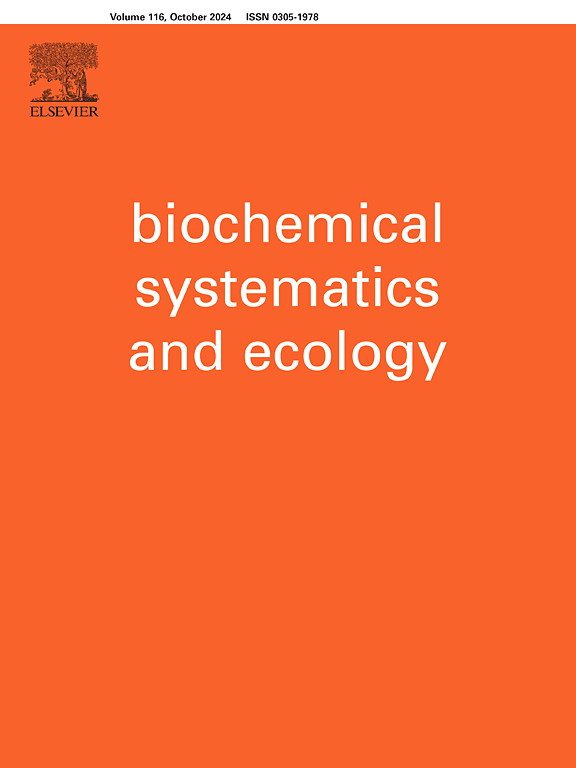Chemical constituents of Ulmus pumila L. and their chemotaxonomic significance
IF 1.4
4区 生物学
Q4 BIOCHEMISTRY & MOLECULAR BIOLOGY
引用次数: 0
Abstract
A phytochemical study of the leaves of Ulmus pumila L. led to the isolation of 32 compounds, including fourteen flavonoids, which include flavonols (1–6), dihydroflavones (7–11), and dihydroflavonols (12–14), five terpenoids, which include megastigmane glycosides (15–17) and triterpenoids (18–19), four sugars (20–23), one phenylpropanoid (24), two phenolic glycosides (25–26), two aromatic glycosides (27–28), one phenolic (29), one lignan glycoside (30), one steroid glycoside (31), and one fatty acid (32). The structures of these isolated compounds were determined by analysis of their NMR spectroscopic (1H and 13C) data and by comparison with previously reported data. Compounds 4 and 8–10 were first reported from U. pumila; compound 12 was obtained from the genus Ulmus for the first time, while compounds 2, 6, 7, 11, 13, 15–17, 19–28, 30, and 32 have never been isolated from the Ulmaceae family. Chemotaxonomic studies have shown that the genus Ulmus may be closely related to the genera Hemiptelea, Zelkova, and Holoptelea.
榆树的化学成分及其化学分类学意义
分离出 32 种化合物,其中包括 14 种黄酮类化合物,包括黄酮醇(1-6)、二氢黄酮(7-11)和二氢黄酮醇(12-14);5 种萜类化合物,包括巨黄酮苷(15-17)和三萜类化合物(18-19)、四种糖类(20-23)、一种苯丙酮类(24)、两种酚苷类化合物(25-26)、两种芳香族苷类化合物(27-28)、一种酚类化合物(29)、一种木质素苷类化合物(30)、一种甾体苷类化合物(31)和一种脂肪酸(32)。这些分离化合物的结构是通过分析其核磁共振光谱(1H 和 13C)数据以及与以前报告的数据进行比较而确定的。化合物 4 和 8-10 是首次从 U. pumila 中分离出来的;化合物 12 是首次从榆属植物中分离出来的,而化合物 2、6、7、11、13、15-17、19-28、30 和 32 则从未从榆科植物中分离出来过。化学分类学研究表明,榆属可能与 Hemiptelea 属、Zelkova 属和 Holoptelea 属密切相关。
本文章由计算机程序翻译,如有差异,请以英文原文为准。
求助全文
约1分钟内获得全文
求助全文
来源期刊

Biochemical Systematics and Ecology
生物-进化生物学
CiteScore
3.00
自引率
12.50%
发文量
147
审稿时长
43 days
期刊介绍:
Biochemical Systematics and Ecology is devoted to the publication of original papers and reviews, both submitted and invited, in two subject areas: I) the application of biochemistry to problems relating to systematic biology of organisms (biochemical systematics); II) the role of biochemistry in interactions between organisms or between an organism and its environment (biochemical ecology).
In the Biochemical Systematics subject area, comparative studies of the distribution of (secondary) metabolites within a wider taxon (e.g. genus or family) are welcome. Comparative studies, encompassing multiple accessions of each of the taxa within their distribution are particularly encouraged. Welcome are also studies combining classical chemosystematic studies (such as comparative HPLC-MS or GC-MS investigations) with (macro-) molecular phylogenetic studies. Studies that involve the comparative use of compounds to help differentiate among species such as adulterants or substitutes that illustrate the applied use of chemosystematics are welcome. In contrast, studies solely employing macromolecular phylogenetic techniques (gene sequences, RAPD studies etc.) will be considered out of scope. Discouraged are manuscripts that report known or new compounds from a single source taxon without addressing a systematic hypothesis. Also considered out of scope are studies using outdated and hard to reproduce macromolecular techniques such as RAPDs in combination with standard chemosystematic techniques such as GC-FID and GC-MS.
 求助内容:
求助内容: 应助结果提醒方式:
应助结果提醒方式:


